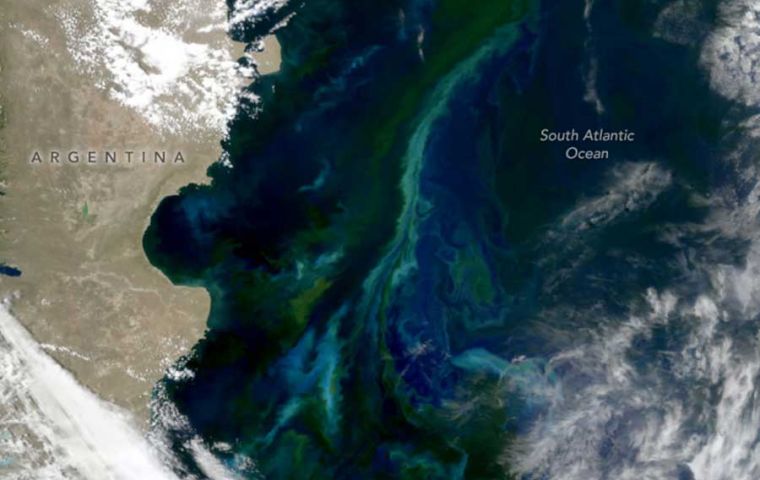MercoPress. South Atlantic News Agency
Patagonian Shelf Waters Abloo in austral spring, NASA Earth Observatory
 NASA Earth Observatory image by Wanmei Liang, using PACE data from NASA EOSDIS LANCE and GIBS/Worldview. Story by Kathryn Hansen.
NASA Earth Observatory image by Wanmei Liang, using PACE data from NASA EOSDIS LANCE and GIBS/Worldview. Story by Kathryn Hansen. An austral spring 2024, a phytoplankton bloom off the coast of Argentina painted the waters blue and green. Blooms are common in the region this time of year, but clouds often block the view from above.
However, clouds stayed hundreds of kilometers offshore on November 30, 2024, allowing the OCI (Ocean Color Instrument) on NASA’s PACE (Plankton, Aerosol, Cloud, ocean Ecosystem) satellite to capture this image of the colorful bloom in the South Atlantic Ocean.
Phytoplanktons are among the smallest organisms in the ocean. But when their populations explode, the blooms can span thousands of square kilometers, making them visible from space. In this scene, the bloom stretches east to west over the Patagonian Shelf and extends over 1,000 kilometers (600 miles) north from the Falkland Islands.
Blooms in this region are stimulated by the ocean’s complex circulation patterns. For example, rising water along the Patagonian Shelf-break front carries nutrients to the surface, where phytoplanktons thrive in spring and summer sunlight. Currents and eddies also stir the water horizontally, creating surface patterns that become even more visible in chlorophyll observations. Other nutrients can come from river sediment and windblown dust from Patagonia.
Without a physical sample, it’s not yet possible to identify the types of phytoplankton present in this image. Studies show that diatoms and dinoflagellates tend to be present here in the austral spring. Diatoms, a microscopic form of algae, have silica shells and plenty of chlorophyll that can make the water appear green. Coccolithophores, which have chalky calcium carbonate plates (coccoliths) that reflect light and make the water appear bright blue, tend to show up in summer.
Phytoplankton are the primary food source for zooplankton, shellfish, fish, and larger marine creatures. With its intense phytoplankton blooms, the area around the Patagonian Shelf-break supports rich aquatic diversity and vast fisheries.




Top Comments
Disclaimer & comment rulesCommenting for this story is now closed.
If you have a Facebook account, become a fan and comment on our Facebook Page!